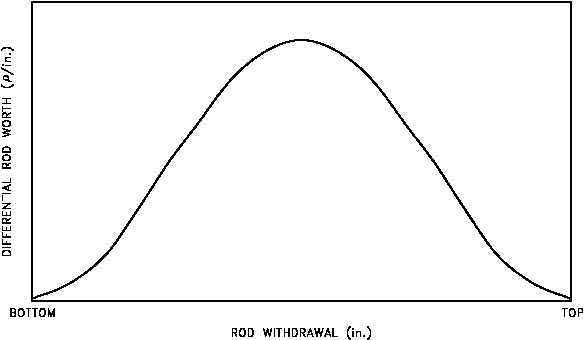CONTROL RODS
DOE-HDBK-1019/2-93
Reactor Theory (Nuclear Parameters)
The slope of the curve (Dr/Dx), and therefore the amount of reactivity inserted per unit of
withdrawal, is greatest when the control rod is midway out of the core. This occurs because the
area of greatest neutron flux is near the center of the core; therefore, the amount of change in
neutron absorption is greatest in this area. If the slope of the curve for integral rod worth in
Figure 9 is taken, the result is a value for rate of change of control rod worth as a function of
control rod position. A plot of the slope of the integral rod worth curve, also called the
differential control rod worth, is shown in Figure 10. At the bottom of the core, where there are
few neutrons, rod movement has little effect so the change in rod worth per inch varies little.
As the rod approaches the center of the core its effect becomes greater, and the change in rod
worth per inch is greater. At the center of the core the differential rod worth is greatest and
varies little with rod motion. From the center of the core to the top, the rod worth per inch is
basically the inverse of the rod worth per inch from the center to the bottom.
Differential control rod worth is the reactivity change per unit movement of a rod and is
normally expressed as r/inch, Dk/k per inch, or pcm/inch. The integral rod worth at a given
withdrawal is merely the summation of all the differential rod worths up to that point of
withdrawal. It is also the area under the differential rod worth curve at any given withdrawal
position.
Figure 10 Differential Control Rod Worth
NP-03
Rev. 0
Page 52


